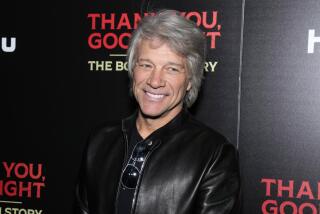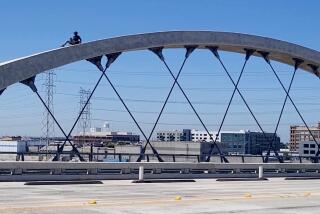Golden Gate Bridge: Triumph, Tragedy : Suicide Rate Shadows the Span’s 50th-Anniversary Celebration
SAN FRANCISCO — Kenneth Baldwin dressed in work clothes and pulled his blue, late-model pickup truck out of the driveway on a beautiful, sunny Wednesday morning. Baldwin was a determined man. He was on his way to jump off the Golden Gate Bridge.
It was Aug. 12, 1985. Baldwin, 28, parked on the south side of the bridge, entered the pedestrian walkway and strolled to the middle of the span. He tried not to look suspicious. Making sure there were no passers-by, and no boats in the bay below, Baldwin was ready. Twice he counted to 10, but lost his nerve. Finally, the third time, he vaulted over the handrail, his body facing the bridge.
Waking Up Swimming
It was a mistake. “From the instant I saw my hand leave the railing, I knew I wanted to live. I was terrified out of my skull,” Baldwin said. After blacking out and plunging 220 feet at a rate of 75 m.p.h. into the frigid water below, he remembers waking up swimming. “I was screaming, ‘Oh God, save me! Oh God, I want to live,’ ” he recalls.
Kenneth Baldwin is one of the more fortunate human beings one will encounter in a lifetime. Rescued by the U.S. Coast Guard, he suffered a few broken ribs and a bruised lung. He is alive and well, living in Tracy, Calif., with his wife, Ellen, and 5-year-old daughter Catherine.
Sunday marks the 50th birthday of the Golden Gate Bridge. Festivities and permanent exhibits will cost about $3.5 million. The 1.6-mile suspension bridge linking San Francisco with neighboring Marin County is world renowned as classic structural art and as a beautiful romantic gateway to the Pacific.
But the bridge has a darker side. Its graceful cables and mist-shrouded 500-foot towers have attracted more suicides than any other bridge in the United States. Since its completion in 1937, the California Highway Patrol has logged 831 confirmed suicides. In an additional 368 cases, witnesses observed people jumping but the bodies were apparently washed out to sea.
Baldwin is one of only 17 people known to have beaten the odds. And bridge officials estimate that for every death, at least five suicides are prevented by intervention.
As San Francisco braces for Sunday’s dawn-to-dark celebration--including a two-hour bridge walk, a cavalcade of vintage autos, a maritime parade, an air show, a carnival, fireworks and entertainment--mental-health professionals are concerned about the bridge’s continuing lore.
“For people depressed and impulsive, the Golden Gate Bridge is like having a loaded gun around the house. It’s an available execution site, and it’s an invitation to disaster,” said Richard Seiden, an Oakland clinical psychologist who has studied bridge suicide.
“Everyone loves a party, but it would demonstrate a certain sort of maturity if San Francisco could celebrate the bridge and at the same time address the issue of suicide,” said Charlotte Ross, director of the nearby San Mateo Suicide Prevention and Crisis Center.
Bridge officials don’t like to talk about the subject. “As soon as you play up suicide (on the bridge), people who are mentally unstable will gravitate toward it,” said Bruce Selby, marketing director for the Golden Gate Bridge, Highway and Transportation District.
The bridge had been completed only three months when in August, 1937, Harold B. Wobber, a 47-year-old World War I veteran, boarded a bus from his home in Palo Alto and later began a leisurely stroll on the bridge with a fellow passenger, a tourist from Connecticut.
Suddenly, Wobber told his new acquaintance, “This is where I get off. I’m going to jump,” and started climbing the rail. Despite the companion’s effort to grab his belt, Wobber leaped over the side. News accounts described him as “a victim of shell shock” who had been under treatment.
His death no doubt stunned Joseph B. Strauss, the bridge’s chief engineer. Interviewed in 1936, Strauss had pronounced the bridge “practically suicide proof.” Citing the intricate telephone and control system, Strauss said “ . . . anyone acting suspiciously would immediately be surrounded,” adding that “suicide from the bridge is neither possible or probable.”
Story After Story
At the San Francisco Public Library, an old wooden card file cataloguing newspaper clippings is a testimonial to Strauss’ miscalculation. Headlines offer dramatic clues, such as “Helpless Cop Watches Death Jump”; “Bridge Leap Ends Sad Love Story”; “Unemployed Man Jumps” and “Suicide Over Wife’s Suit for Divorce.”
The stories allude to troubled romances, family squabbles, emotional disturbances, financial problems and ill health that literally sent distraught victims over the edge. Jumpers included attorneys, homemakers, soldiers, socialites, mail carriers, students and businessmen. In his 1965 book, “Golden Gate: Biography of a Bridge,” Allen Brown noted some of the tragic details.
The bridge’s youngest victim was Marilyn DeMont, a blonde 5-year-old who stood on a girder just outside the bridge’s railing in 1945. It almost seemed like a death game. Without a word, she looked at her father, who commanded her to jump. Then August DeMont, a 37-year-old San Francisco elevator installation foreman, gracefully dived after his daughter. A note in DeMont’s car offered only, “I and my daughter have committed suicide.”
Father and Son
Another unusual twist involved Charles S. Gallagher, credit manager for a large San Jose hardware firm. In 1954, Gallagher seemed to have the good life. He was a director of the San Jose Merchants Assn., drove a late-model car and lived in a new, expensive home.
However, returning from a two-week vacation, Gallagher learned that an audit begun before he left was still in progress. He told co-workers he was going out for coffee. He then drove his sedan north to the bridge and took his life.
Four days later, Gallagher’s son, Charles S. Gallagher Jr., a 24-year-old premed student at UCLA, drove the same car to the bridge and leaped from almost the identical spot. In a short note, young Gallagher said: “I am sorry. . . . I want to keep dad company.”
In recent years, deaths of prominent people have received more attention. When University of California General Counsel Donald L. Reidhaar leaped to his death in 1985, the story was widely covered, including the despair outlined in the 52-year-old attorney’s suicide note.
By contrast, one weekend a year earlier, when Theadora Merez, 20, and James Mills, 49, plunged to their deaths in separate suicides, Reuters news service noted: “The news rates hardly a mention in the local press.”
Experts say only about one-third of suicide victims leave notes. Perhaps the most puzzling, however, was the one left by 49-year-old John Thomas Doyle in November, 1954: “Absolutely no reason except I have a toothache.”
In another strange episode, when David Cleveland’s body was recovered in 1971, officials found $36 in his mouth.
There also have been a fair number of so-called “pseudocides,” distraught people who attempt to take a less traumatic route. The first-known case involved Chris J. Christensen, a prominent jeweler who in 1948 had recently been elected to the San Francisco Board of Supervisors. Apparently, he was unable to cope with pressures of public office.
Christensen, 47, no doubt raised some eyebrows in his era. He had been friendly with someone described as “a willowy young man almost too good-looking to be considered handsome,” whom he introduced as his nephew. The young man was not a relative but rather a sailor Christensen met in a Los Angeles bar.
Christensen’s coat was found tied to a painter’s work box near the center of the bridge, with a note: “Loved Ones: My nerves are shot. Please forgive me. Chris.”
Bible Salesman
Whether his loved ones forgave him is unknown. However, more than a year later, Christensen turned up selling Bibles in Houston, 40 pounds lighter and living in a shabby rooming house. He reportedly said campaign contributors asked him to do things he couldn’t do. He considered himself a failure, and never returned to San Francisco.
No one really knows why the Golden Gate Bridge has become such a powerful symbol for those seeking an end to life. The neighboring Oakland Bay Bridge, built at roughly the same time, is reported to have had only 125 suicides. Interestingly, several Bay Area bridge victims made a point of driving over the Oakland Bay Bridge on their way to commit suicide on the Golden Gate.
Actually, the Golden Gate Bridge suicide rate has dropped somewhat in recent years. Random checks indicate 31 suicides in 1976, 24 in 1980, 18 in 1985 and 17 in 1986. However, despite measures such as installation of television monitors, constant patrols by bridge employes and the California Highway Patrol and closing the sidewalks to pedestrians between 9 p.m. and 6 a.m., suicide attempts remain a constant problem.
The debate over how to prevent suicide has been raging for more than 40 years. In 1948, W. Keene Jackson, a Glendale merchandising broker, proposed installing charged wire similar to an electric pasture fence. His idea was rejected when officials decided the wire would be “a hazard to workmen.”
Bridge directors have, over the years, come up with some novel ideas. In 1949, the district president thought there should be a law against suicide. His legislation was dropped after the San Francisco Chronicle pointed out in an editorial, “A person seriously bent on suicide is not going to be deterred by a law that, once he jumps, can never reach him.”
In 1951, another director proposed posting signs, urging “Think Before You Leap.”
In a more serious vein, mental-health professionals have unsuccessfully tried to get officials to replace the bridge’s waist-high railings with higher barriers. Directors, fearing public resistance to the expense and resultant “ruining” of the bridge’s appearance, have staunchly refused. One director scoffed, “All we’re doing (by installing barriers) is sending them (jumpers) to another bridge.”
Oakland psychologist Seiden adamantly disagrees. Studying would-be suicides who had been restrained, he found that over a 20-year period, fewer than 4% went on to commit suicide. “Most suicidal people aren’t composed enough to concentrate on coming up with another plan,” he said.
Temporary Crisis
Seiden and others note that many people may be suicidal for a few hours or a few days. “Once the crisis is over, these people are out of danger.”
Kenneth Baldwin made his attempt because he was having problems at work. Returning to school for a drafting degree, he had achieved a near-perfect academic record. However, after two months on a new job, he became depressed because he felt he couldn’t deliver what his boss expected. “I felt like a failure, and I reasoned my wife and child would be better without me,” he said.
Why did he choose the Golden Gate Bridge? “I decided not to do anything messy like shooting myself or slitting my wrists. And I didn’t want my family to see me, so that ruled out hanging or pills. And I knew the bridge had good statistics.”
And what would have happened if there had been barriers on the bridge? Baldwin is dismissive. “I have no question that I wouldn’t have done it,” he said.
More to Read
Sign up for Essential California
The most important California stories and recommendations in your inbox every morning.
You may occasionally receive promotional content from the Los Angeles Times.










